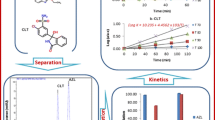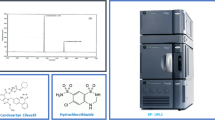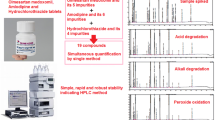Forced degradation studies of candesartan cilexetil (CCX) and hydrochlorothiazide (HCTZ) were performed by using stressed drugs under acid, alkaline, and neutral hydrolysis; oxidation; photolysis; and thermal degradation conditions. A simple and specific method of high-performance liquid chromatography with UV detection was developed for simultaneous determination of CCX, HCTZ, and their degradation products. Optimum conditions were achieved with a running buffer mixture of acetonitrile and 10 mM phosphate buffer (pH 7.0; 32 : 68, v/v) at a flow rate of 1.0 mL/min using a Zorbax stable-bond cyano (SB CN) column (4.6 × 150 mm, 5 μm), 25°C column temperature, and 254 nm UV detection wavelength. This method was validated for linearity, range, accuracy, precision, and specificity according to International Conference on Harmonization (ICH) guidelines. All figures of merit for method validation are acceptable. The method proved to be stability-indicating because it also analyzed drugs in the presence of their degradation products with a resolution of the critical peak pair at least 1.5 and peak purity values greater than 990. CCX was stable under neutral hydrolysis, photolysis, and thermal degradation conditions but degraded under acid and alkaline hydrolysis and oxidation conditions. HCTZ was stable under oxidation, photolysis, and thermal degradation conditions but degraded under neutral, acid, and alkaline hydrolysis conditions.







Similar content being viewed by others
References
M. Bakshi and S. Singh, J. Pharm. Biomed. Anal., 28, 1010 (2002).
Z. A. El-Sherif, B. El-Zeany, O. M. El-Houssini, et al., Biomed. Chromatogr., 18 ,143 (2004).
R. Parveen, S. Ahmad, S. Baboota, et al., Biomed. Chromatogr., 24, 639 (2010).
R. N. Rao, C. G. Naidu, K. G. Prasad, and R. Narasimha, Biomed. Chromatogr., 25, 1222 (2011).%
A. Doomkaew, B. Prutthiwanasan, and L. Suntornsuk, J. Sep. Sci., 37, 1687 (2014).%
T. K. Ravi, M. Gandhimathi, A. Suganthi, and S. Sarovar, J. Sep. Sci., 29, 1647 (2006).
International Conference on Harmonization, ICH Guidelines Q1A(R2), Stability Testing of New Drug Substances and Products (2003).
A. Husain, M. Azim, M. Mitra, and P. Bhasin, J. Appl. Pharm. Sci., 1, 12 (2011).
The United States Pharmacopeial Convention, The United States Pharmacopeia 36 & The National Formulary 31, Rockville (2013), pp. 2774 – 3825.
N. Kumar, K. Babu, U. Gosada, and N. Sharma, Pharm. Methods, 3, 39 (2012).
A. Mohan, S. Shanmugavel, A. Goyal, et al., Chromatographia, 69, 1211 (2009).
D. Rao, P. Radhakrishnanand, M. Suryanarayana, and V. Himabindu, Chromatographia, 66, 499 (2007).
S. Prajapati, P. Patel, M. Patel, et al., Pharm. Methods, 2, 130 (2011).
S. Mehta, R. Shah, R. Priyadarshi, and S. Singh, J. Pharm. Biomed. Anal., 52, 345 (2010).
M. Saira and M. R. Nath, Int. J. Pharm. Pharm. Sci., 5, 867 (2013).
S. Bhagwate, and N. J. Gaikwad, J. Appl. Pharm. Sci., 3, 88 (2013).
R. Kamble, S. Singh, and S. Singh, J. Pharm. Res., 3, 2949 (2010).
M. Tagliari, H. Stulzer, F. Murakami, et al., Chromatographia, 67, 647 (2008).
T. Belal, H. Daabees, M. Abdel-Khalek, et al., J. Pharm. Anal., 3, 118 (2013).
C. Vetuschi, A. Giannandrea, G. Carlucci, and P. Mazzeo., Il Farmaco, 60, 665 (2005).
D. Hertzog, J. McCafferty, X. Fang, et al., J. Pharm. Biomed. Anal., 30, 747 (2002).
A. Khodke, L. Potale, K. Bothara, and M. Damle, Pharm. Methods, 1, 39 (2010).
M. Lusina, T. Cindric, J. Tomaic, et al., Int. J. Pharm., 291, 127 (2005).%
O. Sagirli, A. Önal, S. Toker, and D. Şensoy, Chromatographia, 66, 213 (2007).
M. M. Annapurna, A. Narendra, and K. R. Kumar, J. Drug Deliv. Ther., 2, 48 (2012).
S. Qutab, S. Razzaq, M. Ashfaq, et al., Acta Chromatogr., 19, 119 (2007).
W. A. Al-Onazi, H. W. Darwish, N. A. Al-Arfaj, and M. A. Al-Brashy, Dig. J. Nanomater. Biosrtuct., 8, 1253 (2013).
International Conference on Harmonization, ICH Q2(R1) Guidelines, Validation of Analytical Procedures: Text and Methodology (2003).
T. Unger, Am. J. Cardiol., 84, 9 (1999).
L. Min, Organic Chemistry of Drug Degradation, Royal Society of Chemistry (2012), pp. 34 – 35.
Acknowledgements
This work was supported by the 60th Year Supreme Reign of His Majesty King Bhumibol Adulyadej Scholarship of Mahidol University, the Office of the High Education Commission, and Mahidol University under the National Research Universities Initiative. We are thankful for the kind provision of CCX and HCTZ working standards and raw materials from the Government Pharmaceutical Organization (GPO) of Thailand.
Author information
Authors and Affiliations
Corresponding author
Rights and permissions
About this article
Cite this article
Phechkrajang, C.M., Quynh, P.T.N. & Suntornsuk, L. Forced Degradation Studies of Candesartan Cilexetil and Hydrochlorothiazide Using a Validated Stability-Indicating HPLC-UV Method. Pharm Chem J 51, 416–424 (2017). https://doi.org/10.1007/s11094-017-1625-0
Received:
Published:
Issue Date:
DOI: https://doi.org/10.1007/s11094-017-1625-0




